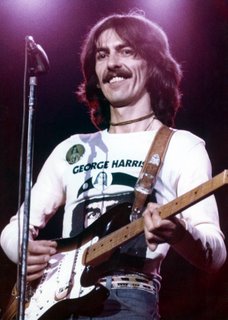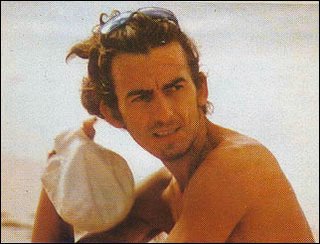George Harrison Interview, 1990
Lese Dunton: I read that you said, "The greatest thing anyone can give humanity is God consciousness." I was wondering how you feel you've done that over the years?
George Harrison: I wouldn't like to say that I'm absolutely God conscious. It's like everybody else. We're battling with the forces that are pulling us upwards and downwards at the same time. But basically we all want love, that's what I feel. And all love is really God's love. It's God's love manifest in this world through everything that's in this world, and all the people in the world. I think what the Krishna thing did for me was the Bhakti -- which is called Bhakti Yoga. It's that method whereby you realize that the Lord is in everything that's in creation. So, when you look at a tree, it's really a reflection of God. You see it in other people -- that's him too, you know?
They take it to the extreme: the food you eat, you taste him on your tongue, you hear him in the music. There's the whole significance of Krishna as the flute player who awakens our consciousness. It doesn't necessarily have to be a flute because for me it was a sitar or a guitar or even Elvis Presley doing "Heartbreak Hotel." It was like Krishna's flute calling me somewhere. It's just really simple when we can remember. I think the main thing that we have to do is try and train ourselves to remember from moment to moment that God is living within us and within everybody else, and just trying to remember to see that.
LD: Do you think there's a growing number of people who are starting to train themselves to remember?
GH: Yeah, I think it's growing all the time. Definitely, I think it's much more acceptable, the idea of meditation or yoga, the idea of God trying to contact the soul within ourselves. Back in the ‘60s it was a bit like, you know, the hippies or the philosophers were the only people. I was brought up in the kind of Catholic situation up until I was about eleven years old, which was that “God is this thing that we're never going to see, we're never going to meet, but you still have to believe in what we say.” It's like this blind faith in something that they can't show you.
The first thing that made me really realize that it was available was a book on yoga that I got on one of my early trips to India. It was called Raja Yoga by the Swami Vivekananda. Right on the inside of that book cover he said, "If there's a God, we must see him and if there's a soul we must perceive it. Otherwise, it's better not to believe. It's better to be an outspoken atheist than a hypocrite." Then, on reflection, I realized that the Christianity that had come in my life as a child was all this idea that you're never going to see him. It's like hypocrisy, in a way.
That's why I wrote in "My Sweet Lord," "I really want to see you," because if there is a God, I want to see him. I don't want to just hear some Holy Roller shouting about him. And the same with the Pope, I want the Pope to say, “Okay, I would like the Christ consciousness.” I don't want to just talk about him.
LD: That line struck me when it first came out.
GH: Yeah, we all want to see him. And then, when you say, "Where is he?" they say, "Well, you can't see him. He's out there somewhere, but we don't know exactly where he is." Through the Indian philosophy and all that I came into contact with, it just showed me that it's actually inside. He lives in our hearts. It's a matter of turning your consciousness inward in order to then realize that it's in there, and then you can see him outside too. It's just a shift in attitude, really.
LD: What do you think people can do to understand and change themselves?
GH: I think basically people just approach it any way they can. Sometimes you can't just force yourself, but there's a saying: "Knock and the door will be opened." I think the first thing is that people have to have the desire within themselves to find out who they are. Who am I and what am I doing here and where am I going? Those sort of basic questions. Even without picking up a book or anything, if they just ask themselves that sincerely, in the quiet of the night, the door will open. And whether it will be somebody who will come along and say, "Hey, have you read this?" Or, "Why don't you come and look at this?" -- it happens in many different ways.
It's how the Lord gives you, in the garden, all these differed kinds of flowers and trees because if there was only one kind of flower and you didn't like it, it would be bad. So, there's just an abundance of ways of approaching that which is within ourselves. I think that the basic answer to your questions is that it has to start within the individual. They have to have a desire within themselves to know who they are and the reason why they are in this body.
LD: How about the future for you? Is there more that you want to know spiritually, musically?
GH: Oh yeah. I still feel like everybody else, that I'm just growing and learning. Basically, I feel pleased to have discovered this thing that's inside me, that's connected to the same thing that's inside everybody and everything. I think now it's just a matter of trying to hold onto it and manifest it more and more. If I feel love, I just want to feel more love. And if I feel a bit of peace, I want to feel more peace. But I don't really have any great ambitions. I feel very happy. I've got a lot of good friends. I just want it to be better and more of it, really. (Laughs.)
LD: How do you think the world is changing?
GH: Well, I've learned from the Bhagavad-Gita that it is not something that's just this mystical baloney that doesn't relate to our lives now. What it is, is explaining this dual energy that is pulling us one way -- upwards into higher consciousness -- and its opposing energy which is just the nature of this physical world, trying to pull us down.
What the Bhagavad-Gita says is that it's man's moral judgment from moment to moment as to which way we get pulled. We can go up or we can do down. I think generally the world is going on an upward swing. We're in a part of a cycle where people are discovering more. The communications are better. We're getting more into the subtle electricity that controls the universe. We don't, as a collective life on this planet, all get groovy together or all sink into ignorance together. One by one we liberate our souls, our individual souls, from the cycle by our own realizations. So, one by one, each soul gets "released from that Memphis Blues again," you know?
LD: So it's up to each person.
GH: It is. It's deep down to each person. So in one way, we're on an upward swing, but at the same time there's still a lot of evil that goes on in the world. I think it's definitely heading in a better direction, but it seems to take so long for all the people with the power, who control the negative side of life and all the bad inventions they have like guns and bombs and hate. But there has to be a balance. We've got to all try harder to manifest more love in order to counteract all that.



